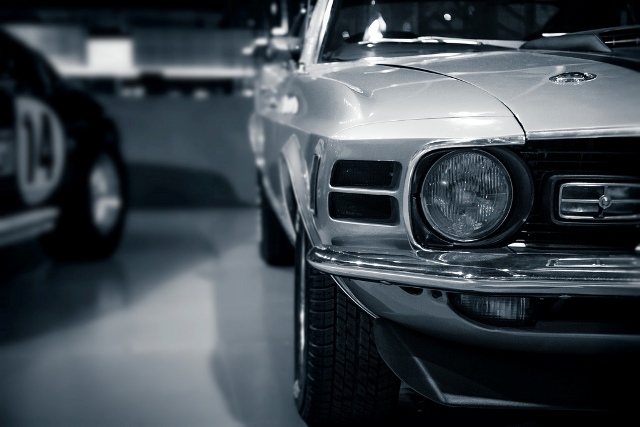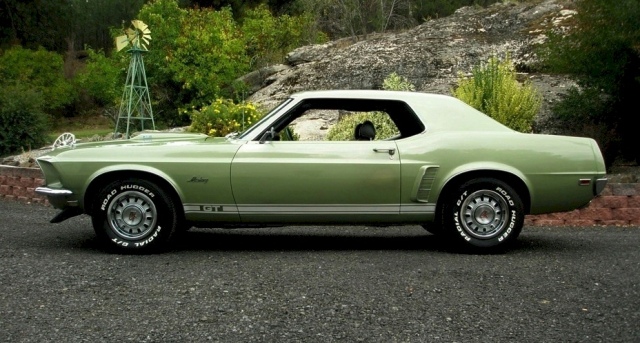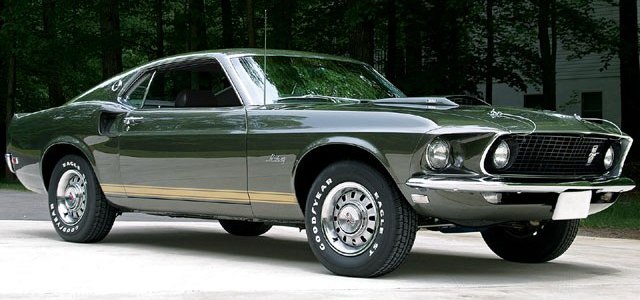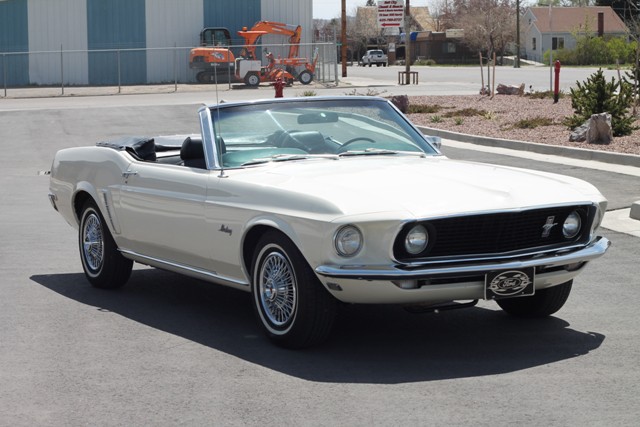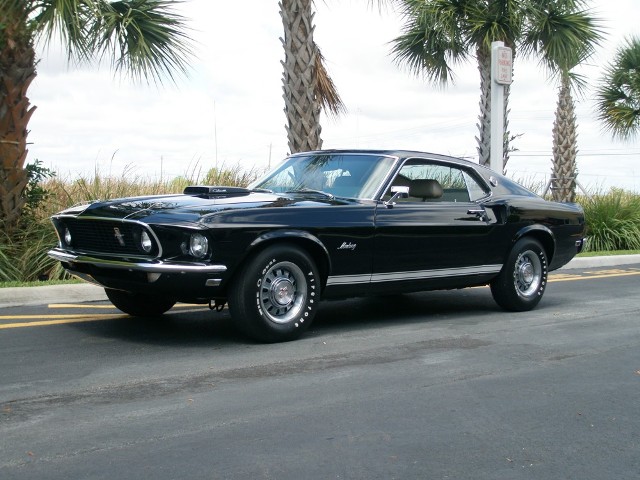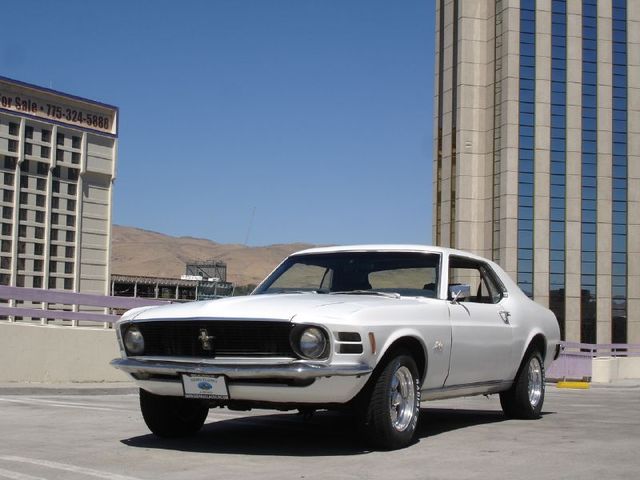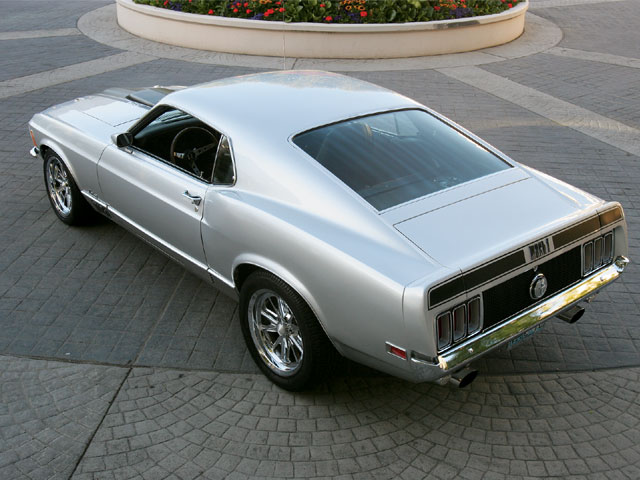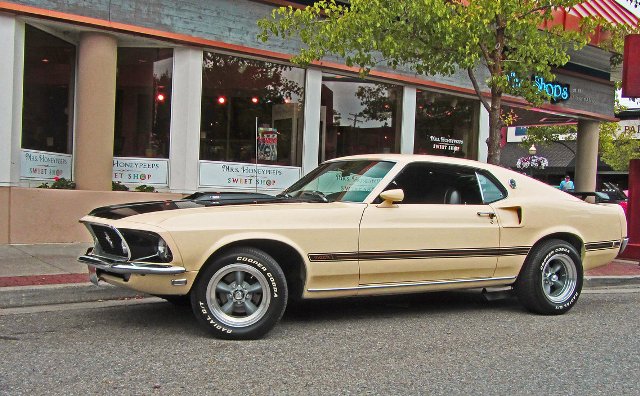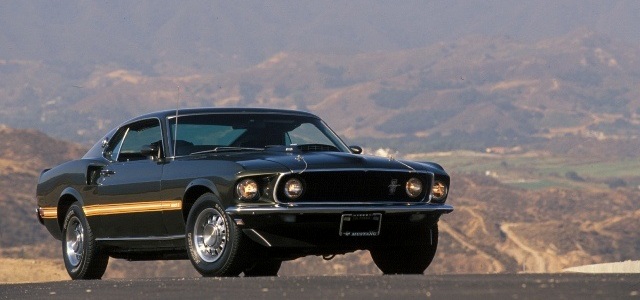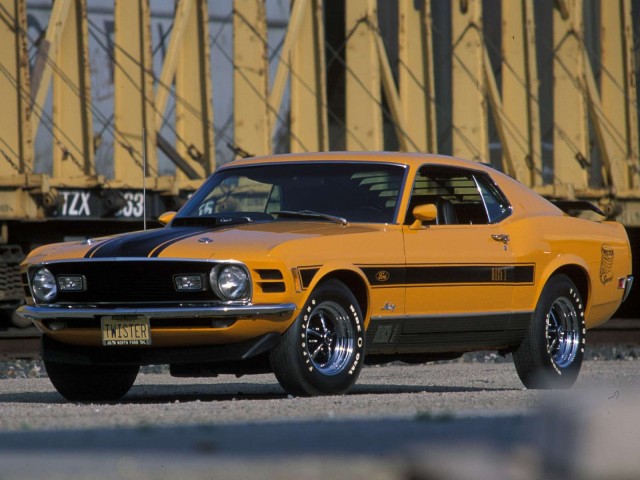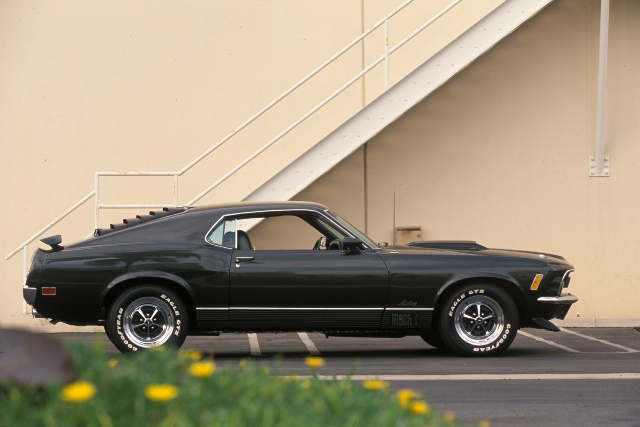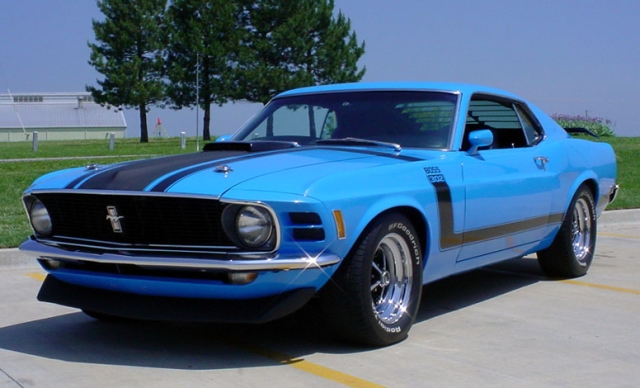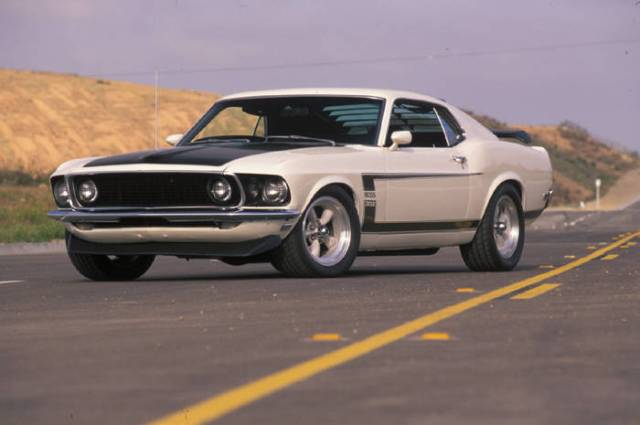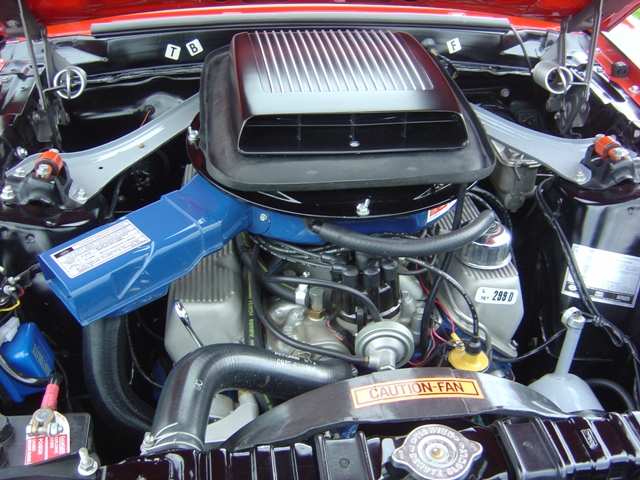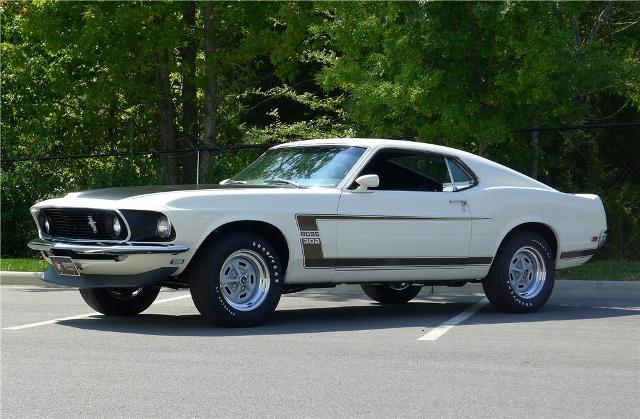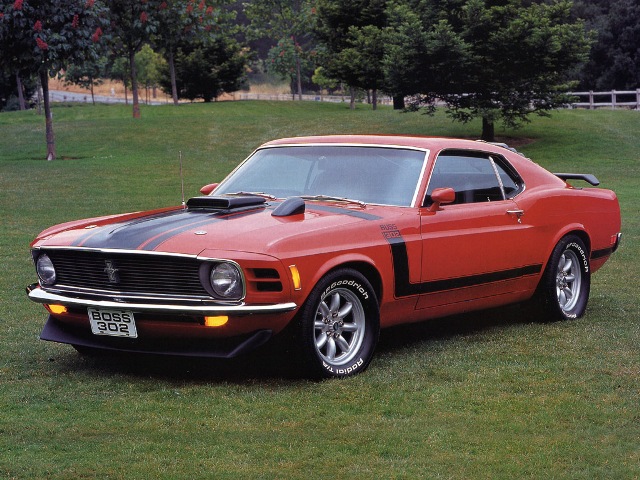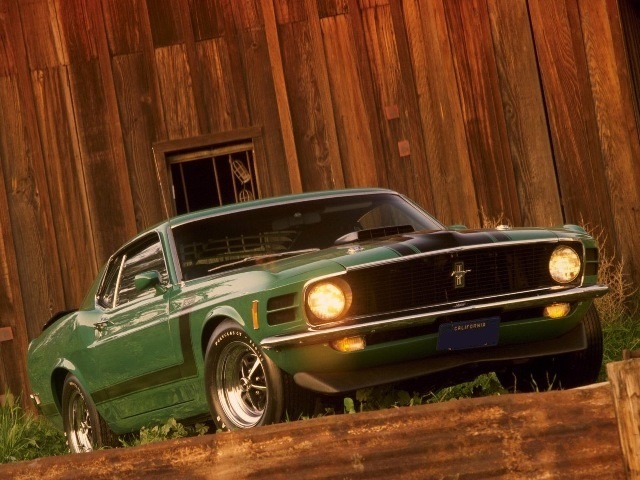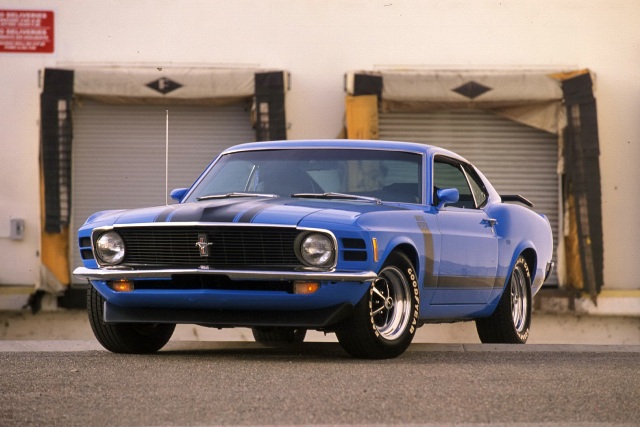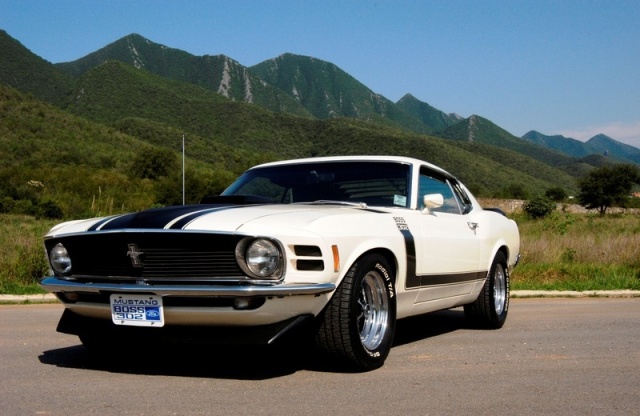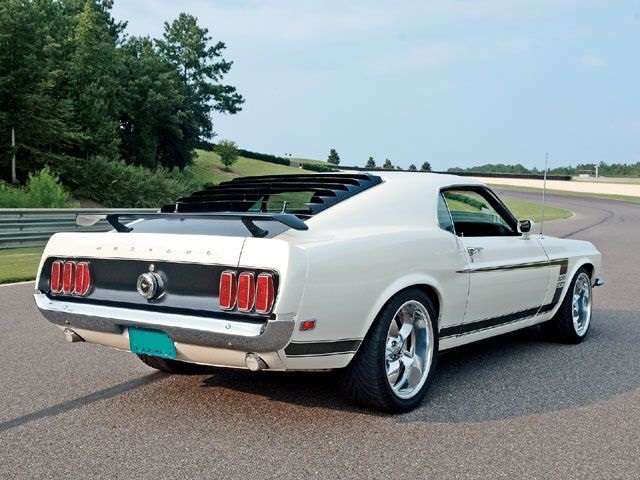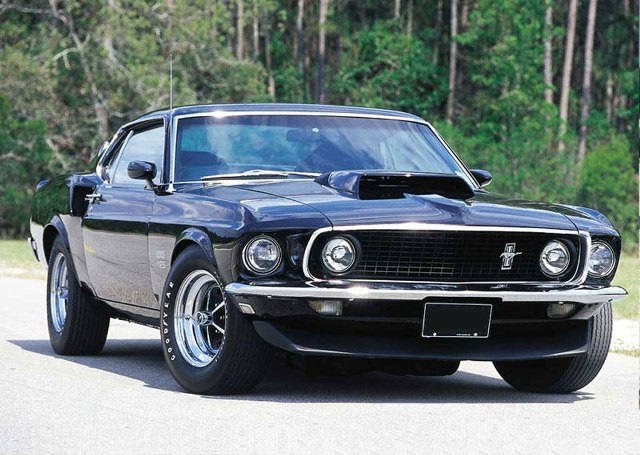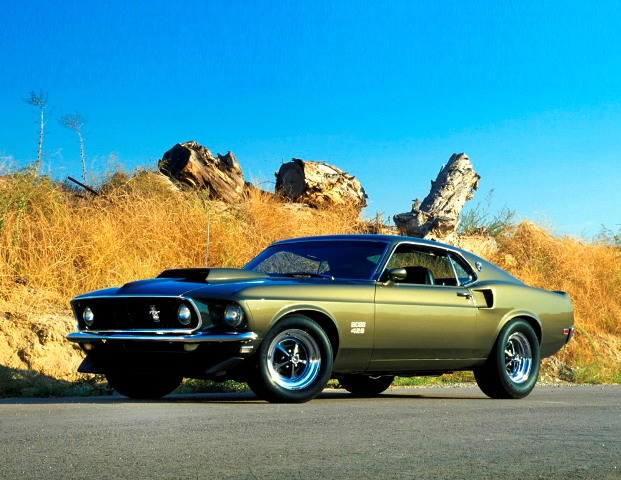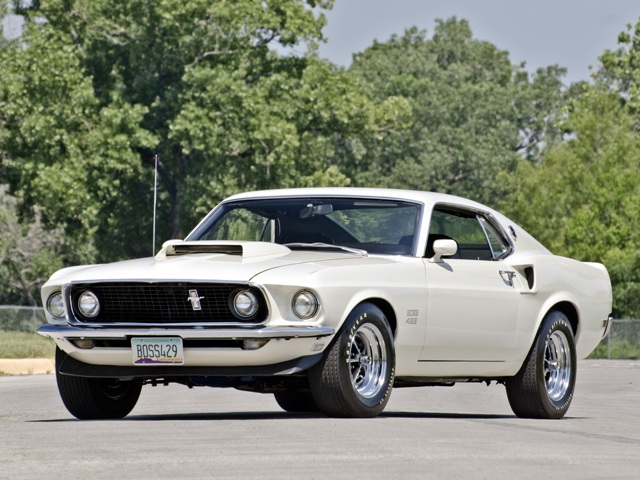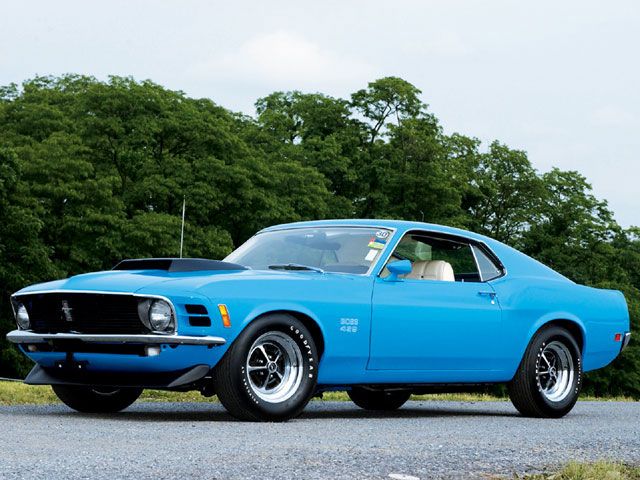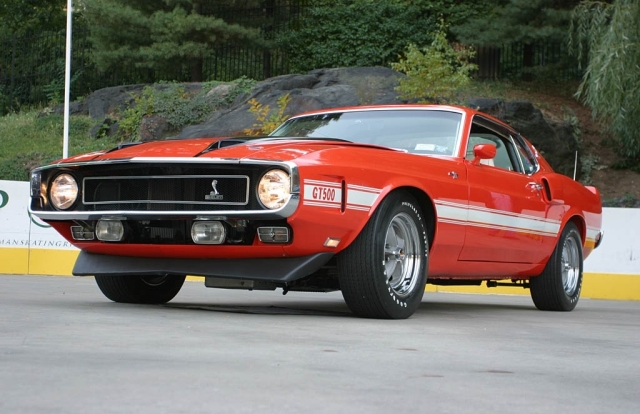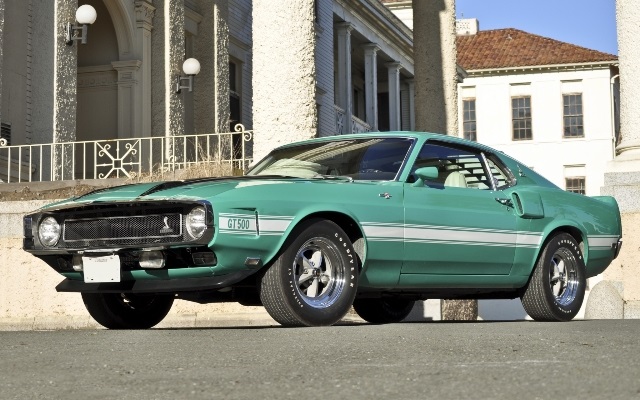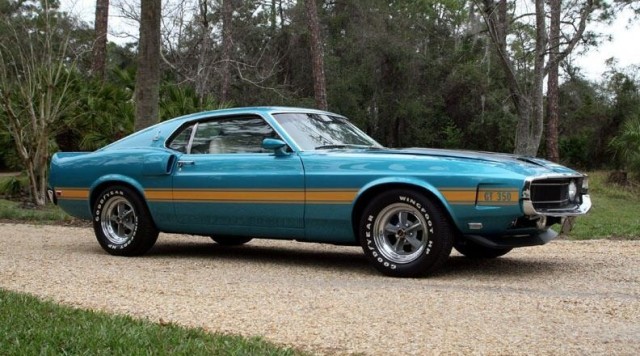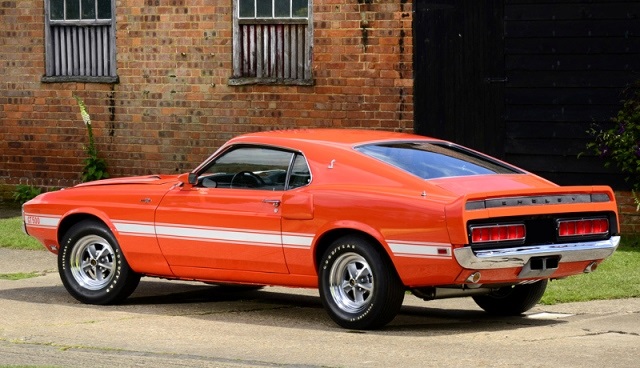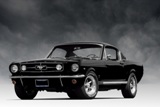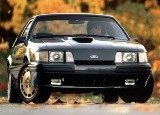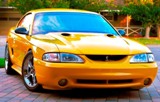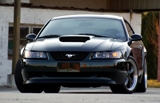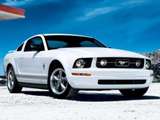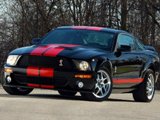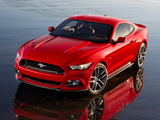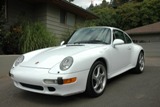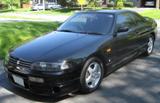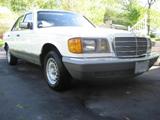Enthusiast's Corner
1969-1970 Ford Mustang: More Power!
Written by James Dolan
Once again the Mustang was altered for 1969, just two short years after the gorgeous ’67 was rolled out. And once again the car grew both in size and in weight. It seems as if Ford had opened up a Pandora’s Box of sorts when they increased the girth of the Mustang two years earlier and they just couldn’t resist the temptation to make the car larger at every opportunity. While Ford had legitimate reasons to increase the size back in ’67, in order to slip in some big block power; the ’69 really didn’t need to grow. It seemed that the attitude was, “bigger the better” within the hallways of Ford headquarters concerning the Mustang. This was the beginning of a troubling trend for the once small and light sporty car. Not like the new Mustang was obese, however it definitely wasn’t fit and trim.
Although the Mustang was increasing in size and heft it continued to look sleek and purposeful, yet more serious and mature. For the first time the Mustang had quad headlamps. The low beam lamps huddled in fender scoops that flanked a broader grill housing high-beam lights at either end. Both hood and grill were vee’d to extend the Mustang’s nose further out front. Absent from the design was the signature body side sculpting. This was replaced with a subtle character line that ended just behind the door. On coupes and convertibles a non-functional reverse facing scoop was placed below the character line.
All three body styles now had little quarter windows directly adjacent to the door glass but lost the front vent windows. The convertible befitted from the new look and came off looking especially handsome and less like a coupe with the roof chopped off. Coupes had a new roofline that was equally as pretty as the swoopy fastback. Mini flying buttresses framing the rear window is an especially thoughtful styling queue that is exclusive to the coupe. Fastbacks were now known as the ‘SportsRoof’ and sported and even faster raked rear roofline extending far back to the end of the trunk terminating at a subtle ducktail spoiler. Unique to the SportsRoof models were large, aggressive rear-quarter scoops placed just aft of the door capping the bodyline. These scoops may have looked like they had the ability to hoover-up small animals or wayward children but in actual fact these were non-functional add-ons. The vertical tri bar taillights continued on but now resided in a flat back panel.
Inside, the interior received an update with a redesigned dash featuring larger twin cowls that were now angled down to give the illusion of greater space. The optional clock was housed in a round recess directly in ahead of the front passenger. Interior space grew right along with the exterior. Thinner doors resulted in more hip and shoulder room. Rear leg room was improved by an astounding 2.5-inches and trunk capacity increased as well.
‘More is better’ must have been the adage of the Ford Motor Company back in the late 1960’s. I can just imagine walking down hallways at Ford world headquarters lined with framed motivational posters boldly stating ‘When you think you are done, just add more!’ Sure this is an exaggeration however it is hard to deny that the philosophy didn’t permeate through the company in those days.
Just as bigger was considered better for the exterior of the car, available engine choices hit an all time high. A staggering seven engine choices were available in ’69 and this is excluding the available power plants in special models like Shelby’s and the new Boss’s. Standard engine continued to be the 200-ci six with a dismal 115-horsepower. Joining the small six was a more acceptable 155-horsepower 250-ci six that was optional. The 302 returned as the basic V-8 option with 220-horsepower. New to the roster was the 351-ci Windsor with either a two-barrel or four-barrel carburetor each churning out 250 or 290-horse power respectively. Both the390 FE big-block and 428 Cobra Jet returned for an encore. Also new were the engines for the new Boss models, but we’ll cover that later on. The long list of engine options may seem a little excessive; however this did allow a customer to tailor a Mustang in any way they desired from mild to wild and everywhere in between.
The Mustang continued to appeal to many segments of the marketplace and wasn’t solely performance oriented. For those who were swayed by style and comfort the semi-luxurious Grande was created. Available in the only as a coupe, the Grande was engineered to be softer and gentler with special rubber suspension bushings to isolate road shock. An additional 55-pounds of sound insulation was added to make the Grande whisper quiet while cruising down the road. Exterior touches included a vinyl-covered roof; bright moldings; two-tone accents stripes; wire wheel covers; and curiously “racing” style mirrors. Interior up-grades included a standard clock; simulated teakwood accents on door panels and dash; and special seats with “hopsack” cloth inserts and vinyl bolsters. With all its refinements and amenities the Grande was a mini Thunderbird cloaked in Mustang attire.
For 1969 the 428 Cobra Jet made a triumphant return but now it didn’t require the GT option group. Also Ram-Air wasn’t automatically included when the 428 was specified but with either option the 335-horsepower rating remained. The biggest change to the 428 in ’69 was when a customer did order the Ram-Air option. The hood-scoop was replaced with a fully functioning black ribbed scoop that was affixed to the top of the air cleaner assembly on top of the engine. This device poked up through a hole cut out of the hood where it could ingest fresh, cool air. Whenever the Cobra Jet was running this scoop would move and shake with the engine thus earning itself the name “Shaker”.
Another new addition was the Super Cobra Jet. Essentially a drag car for the street, the Super Cobra Jet was created when the Drag Pack rear axel option was ordered. Super Cobra Jet’s were equipped with a 3.90:1 or 4.30:1 axle ratio with a Traction-Loc limited-slip differential. The engine was beefed up with forged-aluminum pistons and Le Mans rods. An external engine oil cooler was mounted on the front of the radiator core support. The Super Cobra Jet was built for one purpose; to scare the living crap right out of you and maybe to win some drag races too. Most of these cars spent their lives blasting down a strip of pavement a quarter mile long. If you wanted the ultimate straight line experience this car was the one to have.
Since 1969 was major overhaul, 1970 brought about some minor changes as this was pretty much a carry over year for the Mustang. Designers changed the nose, returning to a dual headlamp system. This was accomplished by replacing the outboard headlamps with simulated air-intakes and placing the main headlamps within the grille which it self was changed from a mesh design to thin horizontal bars. The faux body side scoops were axed on all body styles, cleaning up the flanks of the cars. Trim was reorganized and the Grande made due with a half vinyl “landau” style roof although a full vinyl top was optional.
The biggest news in 1970 was in the engine compartment. Basic six-cylinder power trains were carried over from the previous year and so was the 302-ci V-8; however the 351 was completely different. The Windsor 351-ci V-8 was dropped in favor of the new 351-ci Cleveland V-8. On paper the basic specs of the two engines look very similar, but the difference is in the details and the two engines only share their displacement. Where the Windsor 351 is based on the 302-ci V-8, the Cleveland 351 is based on the 335-series engines and was the engine of choice to power Ford’s high-performance cars from 1970-74
The Cleveland engine used a unique block with an integral timing chain and water crossover passage at the front. Cylinder heads of the two engines were completely different. The Cleveland engine had a free flowing head design with canted valves to form a modified wedge-type combustion chamber. Cylinder heads also varied between the two and four-barrel carburetor set-up. Cleveland engines equipped with four-barrel carburetors had heads with wedge-shaped combustion chambers and larger valves where the two-barrel carburetor head made due with smaller valves and an open chamber design.
Even the crankshaft is different from the Windsor 351 and Cleveland 351 with the Windsor using larger main and crankshaft journals. The 351 Cleveland with its free-flowing heads went on to become a much vaunted high-performance small block V-8. In 1970 the Mustang was available with the 2-barrel, 250-hosepower 351, as well as the better breathing 4-barrel, 300-horsepower version of the 351 Cleveland.
Since 1969 was the final year of production of the FE-series engine, the venerable 390 was dropped from the option list and not replaced. Big block engine duties were now left to the spectacular 428 Cobra Jet that was still being underrated at 335-horspower. Along with the ‘normal’ Cobra Jet the Super Cobra Jet continued right along into 1970. The biggest change to the Super Cobra Jet was the availability of the clunky yet effective Detroit Locker differential with a 4.30:1 ratio. The Traction-Lok diff was still used when the 3.91:1 ratio was ordered.
1969-1970 Mustang Mach 1
By combining an intoxicating elixir of various option packages and trims, Ford developed the Mach 1 for 1969. With luxury elements taken from the Grande and performance components from the GT option group, the Mach 1 had a large breadth of appeal among consumers. The concept of the Mach 1 was to produce a more civilized performance machine in comparison to the badass race-bread Boss Mustangs. Available only on the SportsRoof body style, the Mach 1 came packed with standard goodies like a 250-horsepower 351 V-8 with dual exhausts, GT handing suspension, Comfort weave vinyl seat inserts and the sound insulation from the Grande.
Outside the Mach 1 dripped with visual appeal making the car hard to miss. There was a matte-black hood with non-functional hood scoop and racy hood pin tie-downs. A chin spoiler that was painted matte-black to match the hood was added below the front bumper. Eye-catching reflective ‘Mach 1’ striping adorned the sides and tail of the car. White-letter Goodyear tires mounted on attractive styled steel wheels filled the wheel wells. Body colored racing mirrors from the Grande was standard as was a cool pop-open gas cap in the back. Rounding out the Mach 1 was a rear deck spoiler painted to carry on the matte-black theme. Visually every Mach 1 looked the part of a dedicated road racing machine even though it wasn’t one.
Inside, the Mach 1 was elegant and livable with high back bucket seats with those classy Comfort weave inserts, Teakwood accents from the Grande embellished the dash and door panels and a centre console was made standard.
Under the hood there was some dash to go along with the flash. The real beauty and appeal of the Mach 1 was that the car could be ordered as mild or as wild as the customer wanted or could afford. Dual exhausts were standard on all Mach 1’s. The base engine was a 351-ci, 2-barrel carbureted V-8 with 250-horspower that provided the Mach 1 with enough thrust to accelerate with authority, yet wouldn’t offend the person who was more interested in the car’s visual appeal and luxury appointments. Optional engines included the 290-horsepower 351, the 320-horse 390 big block and the fire-breathing 428 Cobra-Jet that could be had with or without the marvelous Shaker hood scoop.
For 1970 the Mach 1 carried on with some styling, power train and detail changes. For 1970 a rear stabilizer bar was added to the suspension allowing the March 1 to corner flatter.
Externally the Mach 1 had a specific plastic grill with rectangular driving lights installed inboard of the main headlamps. Twist-type hood locks replaced the hood pins and the hood now had a thinner low-gloss black or white stripe up its centre that was barely wider than the hood scoop. Aluminum ribbed rocker panel appliqués with dark painted accents and die cast ‘Mach 1’ letters attached just aft of the front wheel opening were added and the reflective tape stripes from 1969 were removed. At the rear a flat black honeycomb rear panel was installed between the taillights, die-cast ‘Mach 1’ letters were affixed to the trunk flanked by a wide tape stripe on either side that was again black or white and oval exhaust outlets added some flair the back end.
The biggest change to the Mach 1 was under the hood. The Windsor 351-ci V-8’s were replaced with the new, better breathing 351-ci Cleveland V-8’s. The base 2-barrel H-code Cleveland 351 still managed to put out a respectable 250-horsepower. The optional M-code 4-barrel Cleveland 351 now had a stratospheric compression ratio of 11.0:1 and put out put of 300-horsepower an improvement of 10 horses over 1969. The gnarly 428 Cobra Jet retuned for 1970 but the big block 390-ci FE engine was dropped.
With a wide scope the Mach 1 with its luxuries and performance elements proved to be an irresistible proposition selling just over 110,000 units between 1969 and 1970.
1969-1970 Boss Mustangs
The Boss Mustangs were the brainchild of former General Motors executive Semon “Bunkie” Knudsen. Knudsen was a performance car junkie and loved any vehicle with power and good looks. He loved nothing better than making factory hot rods that knocked out the competition. When Knudsen arrived at Ford he thought that the Mustang was a good looking car but lacked in all-round performance areas such as handling. Development of the 428 Cobra Jet was already well underway when Knudsen made the move from G.M. over to Ford; after being lured away by Henry Ford II. Knudsen liked the 428 Cobra Jet but he felt that the Mustang also needed to be a better all round performer not just straight line scorcher.
In 1967 General Motors created the Chevrolet Camaro Z/28 to compete in SCCA Trans Am racing. The Z/28 was a nimble corner carver with a screaming high rpm small-block V-8 that could smoke it tires just as well as it could handle a curve in the road. Ford had nothing to compete with the Z/28 and Knudsen was about to change that.
At the same time Ford had a new 429-ci engine that needed to be installed in a vehicle in order to be homologated for NASCAR use. One of Knudsen’s first decisions was that the Mustang should be the car to have the 429 “Blue Crescent” engine installed into it. This is how the Boss Mustangs came to be. With help from Larry Shinoda who defected to Ford along with Knudsen the two men began working on the new cars in earnest.
The Boss 302
Exactly five years after the debut of the original Mustang the first Boss 302 rolled off the production line. In order for the Boss 302 to compete in the SCCA Trans Am series Ford needed to produce at least 1,000 copies of these special Mustangs to homologate the car for series, but Ford ended up producing many more than that. Despite being a low volume, no nonsense performance car the Boss 302 brought people into ford showrooms in droves and did wonders for the brands reputation. The idea of a Mustang that boasted crisp handling and tenacious grip, powered by a small, yet powerful, screaming V-8 roused excitement within the car enthusiast community.
Power was supplied by an exclusive small-block 302-ci V-8 that was specially made for the Boss 302. Just as Tasca had done with the 428 Cobra Jet engine; the Boss 302 was cobbled together with existing parts from the Ford parts bin. Engineers used a 302-ci Windsor tunnel port four-bolt main bearing block and bolted on the heads from the new 351 Cleveland V-8. By coincidence the bolt pattern of the 351 Cleveland heads mated perfectly to the 302 Windsor block. With canted valves, large ports and free breathing design the 4-barrel Cleveland heads would allow the 302 to ingest copious amounts of air at high engine revolutions. The valve-train was enhanced with stronger valve springs to prevent valve float at upper engine speeds and solid lifters for added durability. An aggressive cam was installed to get the most air in and out of the free-flow heads and get the most out of the improved valve train. On top an aluminum high-rise manifold was installed topped by a super high flow Holley four-barrel carburetor being fed by a high flow fuel pump.
Installed inside the block went a hardened, cross-drilled, forged-steel crank, forged connecting rods with heavy-duty rod bolts connected to TRW forged-aluminum domed pistons that gave the Boss 302 a high 10.5:1 compression ratio. Lubrication was improved with a high flow oil pump and a baffled 5-quart oil pan with windage tray used to prevent all that oil from sloshing around and starving the oil pump of oil when the car was cornered hard.
An under-drive pulley was used for the alternator, a balanced water pump impellor and a special five-blade flex fan was used for reliability at extreme engine speeds. According to factory specifications the Boss 302 engine was claimed to be capable of safely reaching 7,000 rpm; however because of warranty concerns production Boss 302’s came equipped with a rev limiter that cut current to the ignition at around 6,000 rpm. This limiter was easily and often defeated by simply unplugging the unit so the owner of a Boss 302 could experience the full effect of this epic little small-block.
Advertised power was rated at a conservative 290-horspower at 4,600 rpm but actual output was estimated to be just shy of 400-horsepower. By no means could this small-block Mustang be considered a poser in the power department.
Getting all that power to the road was handled by ether a close or wide ratio Top-Loader four-speed manual. Ford’s virtually indestructible nodular nine-inch rear end was used with heavy-duty 31-spine rear axels. Standard final drive ratio was a short 3.50:1; with 3.91:1 and an extremely short 4.30:1 available as options and mandatory oil cooler was added if either of those optional ratios were chosen. To ensure that all the torque could be transmitted to the road a Traction-Loc limited slip differential was available and recommended.
Top shelf chassis hardware was used to make the Boss 302 corner like no other car Ford had ever produced before. Steering was ultra-quick, using a 16:1 ratio that allowed the car to dart in and out of corners. Suspension geometry remained basically the same with the only change being the car’s enlarged foot print. High rate front and rear springs were installed along with a large front anti-roll bar. Heavy –duty Gabriel shock absorbers were used up front and staggered in the rear (one in front of the rear axel and the other behind) in an attempt to control axel wind-up.
Enormous F60 Polyglas tries mounted on 15x7 Magnum 500 wheels required that the front fender lips be rolled in order to prevent tire/fender interference. In order to cope with the increased cornering loads that would be produced new, larger spindles were engineered and installed. Prototype testing found that the cornering limits were so high that the upper control arm mounts were overloaded beyond their limits and extra shock tower braces were added to eliminate the problem. Bringing the Boss 302 to a halt was handled by substantial 11.3-inch front discs and sizable 10-inch drums in the rear.
Externally the Boss 302 was graced with full functional front and rear spoilers that began to be effective at as little as 40 miles and hour. During tack testing engineers discovered that the four-inch deep front air dam and adjustable rear spoiler reduced laps times by an outstanding 2.5 seconds. These aero improvements were thanks to Larry Shinoda’s expertise in the realm of airflow management. Shinoda also worked his magic on the Boss’s esthetics.
Accentuating the 302’s purposeful look Shinoda eliminated the non-functional quarter panel scoops from the SportsRoof body and blacked-out the headlight scoops, hood, cowl, and deck lid and rear cove panel. Topping off his creation Shinoda added C-stripes with ‘Boss 302’ proudly displayed on the body sides. Rear window lovers were optional and really had no other function than to add some visual appeal. All the tweaks by Larry Shinoda made the ’69 Boss 302 one of the cleanest looking Mustangs produced from 1960’s.
Changes were few for 1970. SCCA rule changes meant that Ford needed to up the production of the Boss 302 significantly from under 2,000 units in 1969 to over 6,500 for 1970. Many executives at Ford were worried that these cars wouldn’t sell and they would be stuck with a glut of unsold units. Luckily Ford could sell all the Boss 302’s they could make and ended the year with sales of around 7,000 units, proving the popularity of a dedicated high performance vehicle.
Mechanically a rear anti-roll bar was added and this allowed engineers to enlarge the front anti-roll bar at the same time. The crankshaft was no longer cross-drilled in order to save some money and the intake valves were smaller in an attempt to make the Boss 302 run better at low engine speeds. For 1970 the new “Shaker” hood scoop was made available as an option on the Boss 302 ramming denser air in the engine and increasing the car’s ‘cool’ factor even further.
Outside the 1970 Boss 302 received the same styling changes as the rest of the Mustang line-up. The color pallet was expanded to include whimsical colors such as Acapulco Blue, Bright Yellow and Calypso Coral. Buyers who were more adventurous could specify one of the attention grabbing “Grabber” colors like Grabber Green, Grabber Orange or Grabber Blue. But perhaps my favorite color for the 1970 Boss 302 was good old Wimbleton White.
The black-out treatment was subdued with a narrower hood stripe just like what had been done on the Mach 1 but the deck lid and rear cove panels remained unchanged. The body side stripes were changed to a “hockey stick” style that ran up over the front fenders and then down the hood. In my opinion the 1970 Boss 302 is perhaps the most alluring of the entire range of large Mustangs’ produced. Larry Shinoda got this car spot on.
Boss 302 Mustangs are serious performance cars that are endowed with outstanding dynamic abilities that made them a worthy competitor for Chevrolet’s splendid Camaro Z/28. Although it lost out to the Camaro in the 1969 Trans-Am series, the Boss 302 came back to take back the championship in 1970. These cars represent the glory days of Trans Am racing and those hard fought battles between Ford and General Motors were the genesis of the Pony car wars. The 1969-1970 Mustang Boss 302 epitomize everything that the Shelby Mustangs should have been and has to make one curious as to why they didn’t designate it as such. Never the less the Boss 302 has to be one of the best Mustangs ever produced; it is certainly one of my all time favorites.
The Boss 429
The Boss 429’s sole reason for existence was to allow Ford the ability to use a newly developed engine for NASCAR racing. In order for an engine to eligible for racing use, NASCAR required at least 500 production installations; however they didn’t specify which models those engines had to be installed in. Although Torino’s were Ford’s vehicle of choice for racing the NASCAR circuits and were therefore the logical choice for installation of the new 429-ci engine; the Mustang was chosen at the insistence of Bunkie Knudsen.
With its mammoth heads, the 429 was simply too wide to fit inside the already enlarged engine bay of the ’69 Mustang. Just days after Knudsen started working for Ford, he contacted Ford engineer Roy Lunn to solve the fitment issue. In turn Lunn turned to Ford’s performance and racing car contractor, Kar Kraft Engineering in Brighton, Michigan. Lunn recognized that producing the Boss 429 would take some specialized and time consuming modifications that could not be performed practically on the production line.
Working together, Lunn and Kar Kraft were able to carefully wedge the behemoth 429 into the Mustang’s engine bay. Using a Mach 1 as a starting point the team removed the engine and the shock towers. The shock towers were replaced with specially modified and reinforced units and the upper A-arms were moved outward an inch and lowered an inch as well. Finally, they moved the battery to the trunk and used a thinner power brake booster that would clear the valve covers. With these modifications the engine fit, but just barely.
The changes didn’t end there. Knowing that the Mustang’s body would flex under hard acceleration, braces were added between the shock towers and firewall. The suspension was upgraded with heavy-duty spindles; Gabriel shocks were used all around and staggered in the rear. Thick anti-roll bars were added up front and in the back to keep body roll in check. Finally massive F60 Wide Oval tires mounted on Magnum 500 wheels were installed, this necessitated that the front fenders be modified just as they had been on the Boss 302.
Externally the Boss 429 was much more subdued package compared to the Boss 302. Most noticeable item was the addition of a gigantic functional hood scoop that would allow a massive amount of fresh air that was required to run that colossal engine into the engine bay. A chin spoiler was added and subtle “Boss 429” graphics were added to the fenders.
Other elements from the standard Mustang were left alone but one could add a rear spoiler or rear window louvers if so desired. Being based on the Mach1 the interior of the Boss 429 was surprisingly plush for what amounted to a factory race car. Interior Décor package and Visibility Group were all standard however luxuries such as automatic transmission and air conditioning were unavailable.
Beneath that huge hood scoop laid the Boss 429’s party piece and a real cause for excitement. Development of the Boss 429 V-8 began in 1968 when Ford started to explore the performance potential of their new thin-walled 385-series engines that were coming on-line to replace the ageing FE-series. Initial Boss 429 S-code engines utilized four-bolt main bearing caps on four of the five main bearings and a cross-drilled steel-billeted crankshaft with heavy connecting rods that used ½” bolts.
Higher up the engine used aluminum cylinder heads with gigantic inclined valves, hydraulic valve lifters and a semi-hemispherical combustion chamber. Fuel and air were drawn through a 735-cfm Holley four-barrel carburetor mounted atop a dual plane aluminum intake. An engine oil cooler ensured that the engine would run cool.
Later T-code engines traded the heavy connecting rods with different rods and pistons and could be had with either hydraulic lifters or a solid cam and lifter set up. The lighter rotating assembly of the T-code engines allowed the 429 rev higher and faster. Both S-code and T-code engines shared a conservative 375-horsepower rating. Backing up the engine was a close ratio four-speed transmission followed by a Traction-Loc differential housing 3.91:1 gears.
Like the Boss 302 the 1970 Boss 429 continued on with very little changes. Mechanically a Hurst shifter was bolted to the transmission and the rear anti-roll bar was relocated. Cosmetically the hood scoop was painted a low-gloss black and a host of new colors were added to the pallet. Ford pulled the plug on the Boss 429 and ended production on January of 1970. Coincidently the Boss 429 was Bunkie Knudsen’s first project at Ford and it was also the first of his projects to be cut after he was kicked to the curb.
On paper the Boss 429 should have been an epic piece of machinery but in practice on the street it left a little to be desired. The Boss 429 was essentially a racing engine dropped into a production car and as such it needed to be tamed for street use. Designed with massive valves and intake ports the Boss 429 was best suited producing power at high engine speeds. Although the cam shaft was considered aggressive for use on the street it was not capable of fully filling the engine with enough air/fuel mixture. Making matters worse that enormous Holley carburetor was also inadequate for the 429 effectively strangling the engine.
Saddled with these compromises and a rev limiter that would cut out the ignition just as the 429 was about to show its true potential the Boss 429 would consistently fall on its face. Even if you could get the Boss 429 to reach its full potential the chassis was completely overwhelmed by the pavement peeling power.
1969-1970 Shelby Cobra GT350 and GT500
For 1969 the Shelby Mustang was a shell of its former self. Shelby Mustangs were once a fire breathing unbridled supercar but now it was mainly a styling and appearance package. Worse even, was Carroll Shelby himself didn’t have much to do with the car anymore ever since he passed the reins to Ford at the end of the 1967 model run. To add insult to injury the GT350/GT500 were no long on top of the Mustangs performance heap. With the Boss 302 now a superior road car and the Mach 1 as a better luxury/performance value the Shelby’s were lost in the line-up.
To Ford’s credit the GT350/GT500 twins did have distinctive styling. The fiberglass nose and fenders were unique to the Shelby that sported a looped bumper and grille combination that added three inches to the length of the already large car. Dual headlamps were set within the frame of the hefty bumper further separating this Mustang from the rest of the pack. What the Shelby lacked in performance it sure made it up with more than its fair share of scoops, no less than five on the hood alone. The fiberglass front fenders incorporated brake cooling ducts ahead of the front wheels and at the rear was another set of scoops to cool the rear brakes. Thankfully every duct and scoop on this Shelby was at least functional, otherwise they could be deemed as tacky or in bad taste.
Rear styling appeared almost identical to the ’68 Shelby’s save for the license plate that was mounted between the sequential tail lamps, moved from below the rear bumper ware dual centre exhaust outlets were now housed. New 15x7 five spoke wheels became standard although some early ‘69’s were fitted with Magnum 500 wheels.
The 351-ci V-8 was now standard fair for the GT350 replacing the 302 from the past year. However at 290-horsepower it didn’t produce anymore power than what was available in the less expensive Mach 1 but it did have a functional Ram-Air system. The GT500 lost the “KR” designation yet still retained the 428 Cobra Jet with Ram-Air and was still rated at a ridiculously low 335-horsepower. Ford must have realized that the GT500 was no longer “King of the Road” since they had finally charmed the Cobra into submission.
By the close of 1969 it was clear that the Shelby Mustang had lost its charm with both the press and the public. What was once a nimble, light supercar that could corner, accelerate and brake with the worlds best cars of the time, the Shelby Cobra Mustang was transformed into a boulevard poser that had little substance to back up its tough appearance.
Sales tanked, Ford produced 3,200 GT350’s and GT500’s in 1969 and about 790 were left unsold at the end of the year. In the fall of ’69 Carroll Shelby even placed a call to the Ford Motor Company asking if they would discontinue the car since it no longer represented his original vision of a super Mustang. Ford’s executives agreed however there remained the problem of the unsold units.
In a move that would be considered unethical, even illegal today, Ford repurposed the remaining cars as ‘1970’ models by applying new serial numbers, adding the front chin spoiler from the Boss 302 and black hood stripes. Once these cars were sold off that was the end of the Shelby Mustang for over 35 years.
Since its inception in 1965 the Shelby Cobra Mustang had lost its identity and became a compromised sports car. Ford attempted to broaden the appeal of the car by adding more and more chrome, trim and luxury but at the same time they removed the performance features that made this Mustang so special. After four short years they found themselves with a car with a lost identity that no one wanted and a lost marketing opportunity. It’s a real shame since Shelby’s concept of a supercar based on the Mustang had so much potential and great appeal.
As Shelby ended his relationship with Ford a new Mustang was being prepared for release and this one would be the largest Mustang yet.
Click here to continue reading on the next page about the 1971-1973 Mustangs...
Most Popular Articles

Japanese Nostalgic Vehicles: The next trend in classic cars
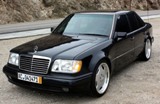
Five Sports Sedan's I'd Love to Own
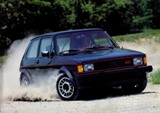
Hot Hatchbacks From the 1980's

Volvo 200 Series: An Unappriciated Classic
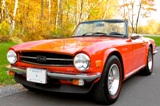
Triumph TR-6: Music to Anyone's Ears
Fifty Years of Mustang
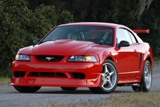
1999-2001 Ford Mustang SVT Cobra
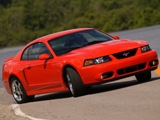
2003-2004 Ford Mustang SVT Cobra
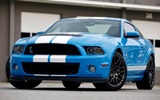
2010-2014 Ford Mustang Shelby GT500
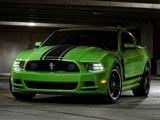
2012-2013 Ford Mustang Boss 302
Driven

Volvo 200 Series: An Unappriciated Classic

Triumph TR-6: Music to Anyone's Ears
1993 Nissan Skyline GT-s and GT-R Coupe

